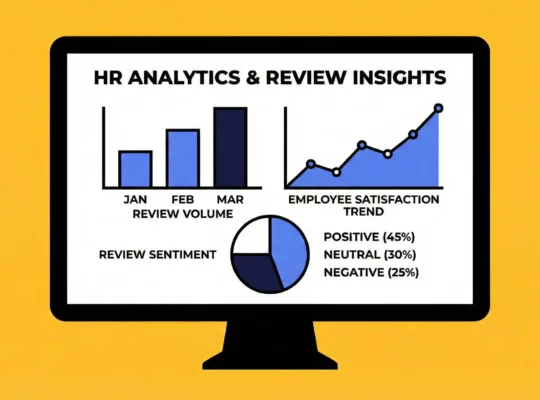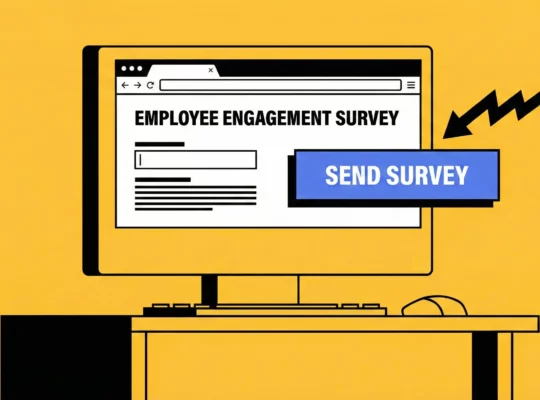Employee reviews sample provide a crucial foundation for shaping workplace culture, boosting engagement, and elevating overall performance. HR professionals and talent acquisition specialists are pivotal in crafting and leading effective performance management. A successful employee review extends beyond just ticking boxes; it encompasses a detailed evaluation of performance, offering valuable feedback to both the employee and the organization. Exploring well-constructed reviews gives insights into how to provide targeted performance review phrases and actionable strategies. This guide will highlight essential elements of a successful review, including the value of using performance review comments and practical real-world examples.
Employee reviews should be more than a formality; they represent a unique opportunity for professional and personal growth – a dialogue centered around valuable manager feedback, alignment, and development for both the individual and organization goals.
Balancing Positive and Constructive Feedback
The Importance of a Balanced Approach
A balanced approach to employee feedback is paramount for maintaining morale and fostering a culture of consistent improvement. Both positive and constructive feedback are essential components of effective performance management. Leaning too heavily on only positive feedback creates stagnation and complacency. Conversely, focusing solely on negatives erodes confidence, creates anxiety, and hinders growth. Striking a balance ensures employees feel appreciated for their achievements while also being motivated and supported to address areas where they need further development.
Providing Effective Positive Feedback
Acknowledging noteworthy achievements, whether they are significant milestones or small daily wins, shows employees that their efforts are recognized and valued. Praise those who willingly undertake challenges above and beyond their day-to-day tasks, reinforcing a sense of initiative. Recognizing the employee’s commitment to meeting and surpassing assigned targets creates a culture where excellence is not just an expectation, but a celebrated accomplishment. Recognizing creativity and fresh thinking with concrete, specific instances illustrates their significance and encourages ongoing innovation.
- Key phrases: “Exceeds Expectations in…”, “Demonstrates Strong…”, “A Valuable Asset Because…”
- Example: “Sarah consistently exceeds expectations in project management. With her proactive approach and with superb attention to detail, she contributes greatly to the successful launch of vital new company events. She is a valuable asset to the team because of her ability to preempt potential roadblocks and develop real-time solutions.”
Delivering Constructive Feedback for Growth
When offering suggestions for improvement, concentrate on specific actions instead of making broad generalizations, steering clear of focusing on personality traits, focusing instead on professional ones. Deal with areas of concern promptly and directly, demonstrating a commitment to their professional growth. Address any performance gaps with actionable steps to improve and targeted support.
- Key phrases: “Area for Improvement:…”, “Opportunity to Enhance:…”, “Consider Focusing On…”
- Example: “An area for improvement is Sarah’s verbal communication during team meetings. While her written reports are consistently excellent, actively participating and sharing insights during discussions could boost collaboration and guarantee all perspectives are taken into consideration. Consider focusing on concise and impactful contributions during meetings to ensure your voice is heard effectively.”
Setting Clear Expectations and Goals
The Power of SMART Goals
The SMART goal framework ensures that desired outcomes have clarity and are attainable; It stands for Specific, Measurable, Achievable, Relevant, and Time-bound. This structure is invaluable in clarifying nebulous aspirations into concrete, actionable items. Instead of setting a vague goal like “improve customer service,” a SMART goal would be: “Improve customer satisfaction scores by 10% by the end of Q3 through targeted skill development training and improved response times.”
Connecting Contributions to Company Goals
When individual goals align closely with the broader strategic objectives of the company, this shows all employees how their work affects overarching business results. Employees are more motivated and involved when they can notice this connection and understand their value.
- Key phrases: “This Directly Contributes to…”, “Supporting Our Goal of…”, “Aligned with Company Strategy…”
- Example: “Your work on enhancing customer onboarding directly contributes to our goal of increasing customer retention by 15% this quarter. This is aligned with the company’s strategic focus on customer satisfaction and lifetime value, making your work extremely significant.”
Collaborative Goal Setting
Emphasizing the importance of employees getting involved in the process brings a personal touch and creates high buy-in. Working together on goal-setting establishes clarity and shared responsibility. By collaborating on performance goals, managers and employees can both agree on clear actionable steps for professional growth and development.
Focusing on Key Performance Indicators (KPIs) and Core Competencies
Identifying Relevant KPIs
Selecting the most relevant KPIs is essential for accurately assessing an employee’s contribution. These KPIs must directly relate to the employee’s role and the company’s strategic objectives, providing a clear measuring stick for performance assessment.
Evaluating Core Competencies
Evaluating core values such as adaptability to change and willingness to learn new skills is vital for employee performance and development. Evaluation of teamwork, cooperation abilities, problem-solving, decision-making skills, and communication skills (both written and verbal) are also imperative. It is additionally useful to evaluate not only professionalism, but also all interpersonal skills.
Examples of phrases assessing KPI and competencies:
- “Demonstrates excellence in adaptability when dealing with unexpected challenges, showcasing incredible resourcefulness.”
- “Actively contributes to collaborative environments, aiding in synergistic problem-solving, with excellent conflict resolution skills.”
- “Shows commendable analytical abilities and exhibits sound judgement during stressful periods.”
Fostering Employee Development and Growth
Identifying Skill Development and Training Opportunities
Noting where the employee has shown considerable progress is crucial because it reinforces their hard work and increases their motivation. Offering resources and support demonstrates a dedication to employee success and enables them to reach for new professional goals. Emphasizing the constant need for learning and growth instills a mindset that is ready for what the workplace is going through. Talking about career aspirations shows employees where their future at the company lies.
Creating an Action Plan for Development
Make and share a development plan for future growth together with the employee that includes the training they need and opportunities for both coaching and mentoring from an experienced colleague or expert. This action plan must identify the appropriate training needs and the chances for constructive coaching.
Practical Review Phrases by Category
Communication Skills:
- Positive: “Communicates effectively, both verbally and in writing.” “Clearly articulates ideas and actively listens to others, showing improved verbal communication.”
- Improvement: “Could benefit from improving active listening skills which may include attending a skill development course.” “Needs to be more concise and direct in written communication, working on written communication is an excellent idea.”
Teamwork:
- Positive: “A valuable team player who collaborates effectively with others across many behavioural competencies.” “Contributes positively to team morale and productivity, aiding in team synergy and boosting employee engagement.”
- Improvement: “Can improve collaboration by actively seeking input from other team members, increasing overall effectiveness.” “Needs to be more proactive in offering support to colleagues, raising overall job satisfaction.”
Problem-Solving:
- Positive: “Demonstrates strong problem-solving skills and thinks critically about difficult issues.” “Effectively identifies and resolves complex issues, showing strategic thinking and decision making.”
- Improvement: “Could benefit from developing a more structured approach to problem-solving, including attending a formal process workshop.” “Needs to be more proactive in identifying potential issues before they escalate, including communication of the issues to the relevant team leaders.”
Time Management:
- Positive: “Effectively manages time and prioritizes tasks to meet deadlines.” “Demonstrates excellent organizational skills that make teamwork effective.”
- Improvement: “Needs to improve time management skills to ensure timely completion of tasks.” “Could benefit from learning new organizational techniques and strategies, allowing improvements in productivity.”
Adaptability:
- Positive: “Adapts quickly to new challenges and changes in the work environment, showcasing a core value.” “Demonstrates a willingness to learn and embrace new technologies, becoming a skilled professional.”
- Improvement: “May sometimes struggle to adapt to unexpected changes, making quick decisions.”
Initiative:
- Positive: “Demonstrates a high level of initiative and proactively seeks out new challenges and responsibilities.” “Consistently goes above and beyond the call of duty to contribute to the team’s overall success, improving workflow.”
- Improvement: “Could benefit from taking more initiative and seeing new opportunities for growth and mentorship from team members.” “Needs to be more proactive in identifying and addressing potential issues before they escalate, communicating quickly and effectively.”
Implementing an Effective Review Process
Creating a Consistent and Fair Process
It is key to use standardized review templates to ensure processes are fair and consistent. Implementing review templates will guarantee that all employees are assessed using similar criteria. Fairness is a crucial element of any review process: eliminate any personal biases and ensure the assessment is based on actual performance
Encouraging Two-Way Dialogue
Reviews should offer an opportunity for continuous dialogue; they are not simply top-down evaluations. Ensure employees can offer self-evaluations which boost engagement and make them feel more valued. Make listening an active element of each review process to gain a deep understanding from the perspective of the employee.
Following Up and Providing Ongoing Support
Regular check-ins and actionable feedback are important to support and track professional growth. Provide a good balance of coaching and mentoring to support the long-term professional development. Consider assessing attendance punctuality if it influences the job role positively or negatively. Acknowledge involvement in establishing a friendly workplace, provide examples of showing the core values of the firm and praise the effective use of organizational skills.
- Acknowledge accomplishments to foster a sense of appreciation.
- Encourage a two-way dialogue during reviews to foster open communication.
- Focus on results and impact rather than simply listing activities.
- Set clear expectations for future performance and behavior.
- Review attendance and punctuality, if relevant to the role.
- Acknowledge contributions to a positive work environment.
Employee surveys are also a great element to add to your Review process
Employee survey: These surveys gather insights into employee satisfaction, engagement, and opinions on various workplace aspects..
Common types of employee surveys include:
- Employee satisfaction surveys: Measure overall job satisfaction and identify areas for improvement.
- Employee engagement surveys: Assess employees’ commitment, motivation, and connection to the organization.
- 360-degree feedback surveys: Collect feedback from peers, supervisors, and subordinates to provide a comprehensive view of performance.
- Pulse surveys: Short, frequent surveys that gauge employee sentiment and address specific topics quickly.
- Exit surveys: Gather feedback from departing employees to understand reasons for leaving and identify areas for organizational improvement.
- Diversity and inclusion surveys: Assesses and understand diversity and inclusion within your organizations, to ensure organizations goals are met.
FAQs: Employee Reviews Sample
What is an ‘employee reviews sample’ and why is it important?
An employee reviews sample is an example of how a performance review should be conducted and documented; it serves as a guide for HR professionals and managers to ensure consistent and effective evaluations. Employee reviews are important because they provide a structured way to give feedback, set goals, and enhance communication, increasing employees to professional greatness.
Who should be involved in the employee review process?
Ideally, the employee, their direct manager, and sometimes HR representatives should be involved. Peer feedback or insights from other collaborators can also be valuable. The senior management team should also get involved.
When should employee reviews be conducted?
Performance reviews are usually done annually, semi-annually, or quarterly, based on the organization’s needs. Regular check-ins and informal feedback should occur more often.
Where can I find suitable templates and example phrases for employee reviews?
Review.jobs, SHRM, and other HR-related platforms offer templates and example phrases. Customizing these resources to align with the organization’s culture and goals is essential.
Why are two-way discussions important during employee reviews?
Two-way discussions allow employees to share their perspectives, concerns, and achievements. This can influence employee engagement, trust, and overall performance.
It is a vital tool that promotes transparency and shared understanding. By actively listening and encouraging open dialogue, managers can gain insights into employee experiences and foster a more collaborative and supportive work environment.
Effective employee reviews are essential for driving performance and engagement. By balancing positive and constructive feedback, setting clear goals, focusing on KPIs and competencies, and fostering employee development, organizations can create a culture of continuous improvement. HR and Talent Acquisition professionals have a vital role in implementing these strategies to ensure that reviews are fair, consistent, and contribute to the employee goals. Partner with Review.jobs as you work towards creating a thriving, successful and effective workplace.





